December 2019 LIP of the Month
~3.44 Ga Ultramafic–Mafic Volcanic Rocks from the Babina and Mauranipur Greenstone Belts, Bundelkhand Craton, India
Pradip K. Singh1, 2*, Sanjeet K. Verma2, Juan A. Moreno3, Vinod K. Singh4, Vivek P. Malviya5,6, Elson P. Oliveira7, Sumit Mishra4,8, Makoto Arima5
1State Key Laboratory of Lithospheric Evolution, Institute of Geology and Geophysics, Chinese Academy of Sciences, 19 Beitucheng West Road, Chaoyang, Beijing – 100029, China.
2División de Geociencias Aplicadas, Instituto Potosino de Investigación Científica y tecnológica (IPICYT), Camino a la Presa San José 2055, San Luis Potosí 78216, México.
3Centro de Investigaciones en Ciencias de la Tierra (CICTERRA), Consejo Nacional de Investigaciones Científicas y Técnicas. Facultad de Ciencias Exactas, Físicas y Naturales, Universidad Nacional de Córdoba, Av. Vélez Sarsfield 1611, Edificio de CICTERRA, X5016CGA, Córdoba, Argentina.
4Department of Geology, Institute of Earth Sciences, Bundelkhand University, Jhansi, India.
5Graduate School of Environmental and Information Sciences, Yokohama National University, 79-7 Tokiwadai, Hodogaya-Ku, Yokohama, 240-8501, Japan. 624E Mayur Residency Ext. Indra Nagar, Lucknow 226015, India.
7Department of Geology and Natural Resources, Institute of Geosciences, PO Box 6152, University of Campinas – UNICAMP, 13083-970 Campinas, SP, Brazil.
8Department of Geology, School of Earth Sciences, H.N.B. Garhwal University, Srinagar, Pauri Garhwal, 246174, India.
*Corresponding author’s email: pradipbu92@gmail.com; pradip@mail.iggcas.ac.cn
Extracted from: Singh, Pradip K., Sanjeet K. Verma, Juan A. Moreno, Vinod K. Singh, Vivek P. Malviya, Elson P. Oliveira, Sumit Mishra, Makoto Arima. 2019. Geochemistry and Sm–Nd isotope systematics of mafic–ultramafic rocks from the Babina and Mauranipur greenstone belts, Bundelkhand Craton: Implications for tectonic setting and Paleoarchean mantle evolution. Lithos 330–331, 90–107.
Introduction
The Bundelkhand Craton (BC) is one of the oldest Archean cratons of the Indian shield, exposed in semicircular shape, which occupied about ~26,000 sq. km (Fig. 1a, b). It mainly consists of TTG gneisses, volcanic-sedimentary greenstone sequences, high-K granitoids, ranging in age from Paleoarchean to Neoarchean (Fig. 1b, Kaur et al., 2016; Singh et al., 2019a, b). The Babina and Mauranipur greenstone belts, located in the central part of the BC, preserves TTG gneisses, greenstone sequences (ultramafic–mafic volcanics, BIFs and felsic volcanics) granodiorite and anatectic granites and show a complex evolutionary history with multi-stage crustal growth (~3.59–2.50 Ga) (Singh and Slabunov, 2015; Kaur et al., 2016; Singh et al., 2019a, b). It is well-intentioned to note that TTG gneisses and granitoids have been widely investigated to understand Paleo–Neoarchean magmatism, petrogenesis and crustal evolution of the BC using field, petrography, geochemistry and geochronology (Mondal et al., 2002; Joshi et al., 2017; Kaur et al., 2014, 2016; Saha et al., 2016; Singh et al., 2019b), however, few studies have investigated ultramafic–mafic volcanic rocks of the Babina and Mauranipur greenstone belts (Malviya et al., 2006; Singh et al., 2018). To date, there has never been any report in the literature about the ages of ultramafic–mafic volcanic units of the greenstone belts. This explains the lack of understanding of formation ages. Further, there is some inconsistency in ideas about the tectonic evolution of this belts. Some researchers suggest that the rocks in the complex were generated in a subduction-accretion tectonic environment (Malviyaet al., 2006; Singh and Slabunov, 2015), which have been recently complemented with processes such as slab breakoff (Joshi et al., 2017; Singh et al., 2019b) and plume-type and plume-arc interaction (Singh et al., 2018). Therefore, in order to get vigorous understandings on Archean earth’s history, additional geochemical and isotopic data are essential. In present study, we report for the first time ID–TIMS whole-rock Sm–Nd isochrone age, as well as major, trace and rare earth element compositions ultramafic–mafic volcanic rocks of the Babina and Mauranipur greenstone belts, BC to determine magmatic age and to enhance understanding of the petrogenesis, crust-mantle evolution, continental generation and reworking during Paleoarchean in the BC.
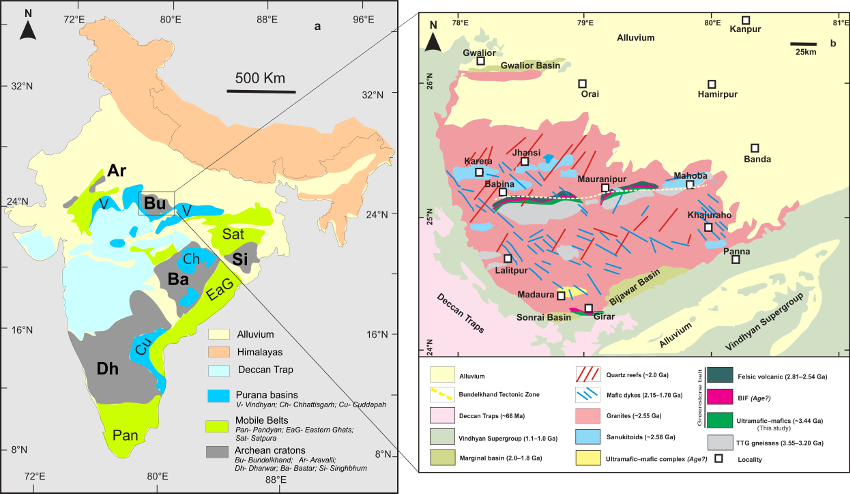
Fig. 1. (a) Geological map of India showing Archean cratons, Tectonic Divisions and (b) simplified map of the Bundelkhand Craton.
Babina greenstone belt
The Babina greenstone belt located about 32 km south of the Jhansi city, well exposed around Babina, Pura village, about 40 km long and up to 4 km wide in E–W trending. This belt comprises three distinct litho-units: i) ultramafic-mafic volcanic rocks, ii) metasedimentary rocks, and iii) felsic volcanic rocks, in stratigraphy order (Singh and Slabunov, 2015). These greenstone sequences intruded by Neoarchean high-K granitoids, Paleoproterozoic mafic dykes and quartz reefs. The ultramafic-mafic unit comprises of basaltic komatiites, basalts and tholeiitic basalt to basaltic andesite that were variably metamorphosed between greenschist to amphibolite facies (Malviya et al., 2006; Singh and Slabunov, 2015; Singh et al., 2018; Singh et al., 2019a).
Mauranipur greenstone belt
The Mauranipur greenstone sequences have well preserved outcrops around the Baragaon village where belt-like exposures, of 4 km long and 1 km wide. They show sparse outcrops around the Raspahari, Kuraicha, and Roni areas (Singh and Slabunov, 2015; Singh et al., 2018; Singh et al., 2019a). Outcrops of pillow lava are observed in the Saprar river section NW of Kuraicha village. Mauranipur belt comprised of three different lithologies: (i) Paleoarchean medium to low-grade metamorphosed basalts and basaltic komatiites (Malviya et al., 2006; Singh et al., 2019a); (ii) BIFs (Singh and Slabunov, 2015); and (iii) 2.81–2.56 Ga felsic volcanics (Singh and Slabunov, 2015).
Whole-rock Sm–Nd isochron
The age of ultramafic–mafic volcanic rocks has been never reported whereas in this study an attempt has been made for the first time to establish emplacement ages. ID-TIMS whole rock Sm–Nd analyses of ultramafic–mafic volcanic rocks from the Babina belt yield isochron age of 3435 ± 161 Ma with an initial 143Nd/144Nd ratio of 0.508268 ± 0.000183 (Fig. 2a). On the other hand, the Mauranipur sample Sm–Nd data did not allow us to obtain a reasonable age. As a result, ~3.44 Ga is considered age of emplacement for ultramafic–mafic volcanic rocks in the BC. The studied samples show εNdt value ranging between +0.2 to +9.0 (Fig. 2b).
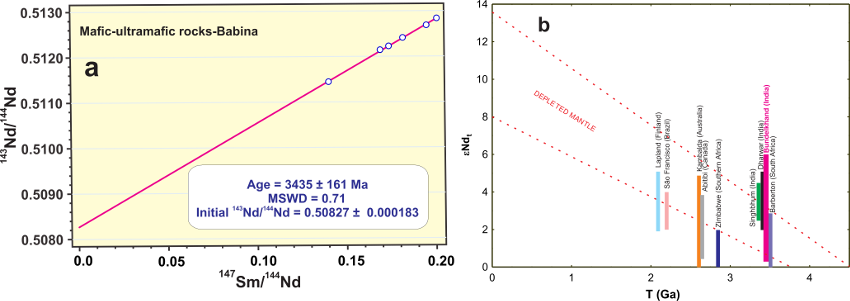
Fig. 2. (a) Whole-rock Sm-Nd isochron for ultramafic–mafic volcanic rocks from the Babina greenstone belt. (b) Time (Ga) vs. εNdt, composition of komatiites and ultramafic–mafic volcanic rocks. The vertical bars represent the mantle source composition from different cratons worldwide, including the data of present study. Age and εNdt, data were taken from (Silva, 1992; Arndt et al., 2008; Jayananda et al., 2008; Chaudhuri et al., 2017; Maya et al., 2017; and references therein).
Petrology and geochemistry
The petrography and mineral assemblages of these ultramafic–mafic volcanic rocks indicate that they experienced greenschist to amphibolite facies metamorphism (Fig. 3 a–h).
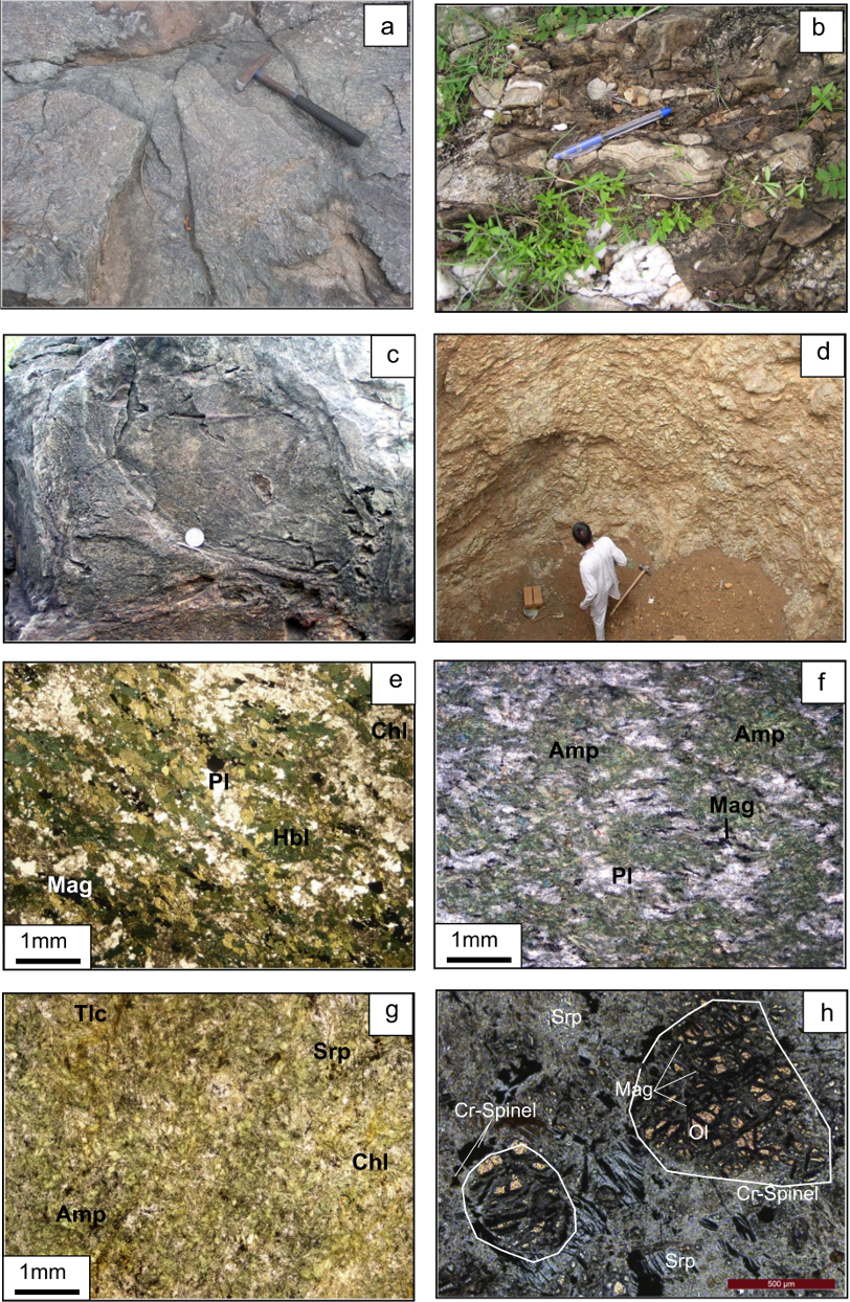
Fig. 3. Representative field photographs and photomicrographs from the Babina and Mauranipur greenstone belts, Bundelkhand Craton. These representative petrographic features are typical of greenschist to amphibolite–facies from both regions. Field photographs (a–d): (a) deformed mafic rocks from the Babina greenstone belt, (b) deformed mafic rocks co-folded with quartzite from the Babina greenstone belt, (c) deformed massive mafic rocks with pillowed structure from the Baragaon area, Mauranipur greenstone belt, (d) showing outcrop of ultramafic in a well section from the Baragaon area, Mauranipur greenstone belt. Photomicrographs (e–h): (e) deformed mafic rocks from the Babina greenstone belt showing texture and mineral assemblages, (f) deformed mafic rocks from the Mauranipur greenstone belt is showing aligned long axes of amphibole, plagioclase, magnetite grains and quartz occur as an interstitial phase (plain polarized light), (g) deformed ultramafic rocks from the Babina greenstone belt showing texture and mineral assemblages, (h) ultramafic rocks from the Mauranipur greenstone belt showing cumulate texture. Relict olivine (Ol) grains are occur within serpentine-chlorite matrix with magnetite (Mag) distributed along the foliation planes subhedral to euhedral chrome spinel (Spl) is present in the serprntinised matrix, (Cross nicol). Abbreviations: Srp–serpentine, Ol–olivine, Mag–magnetite, Cr-Spl–Cr spinel, Tlc–talc, Pl–plagioclage, Chl–chlorite, Hbl–hornblende, and Amp–amphibole.
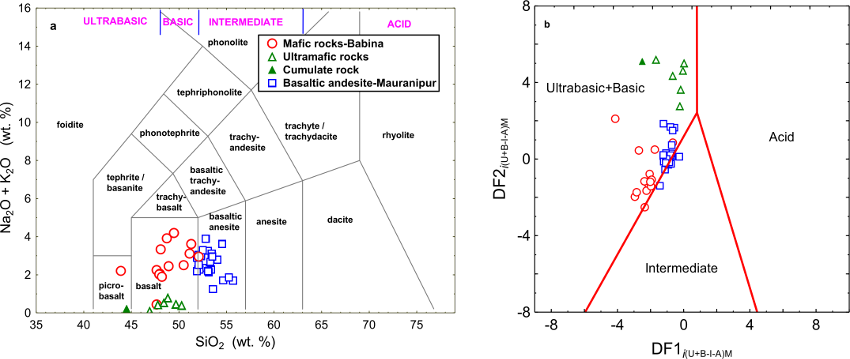
Fig. 4. (a) Sample classification in the TAS diagram. (b) multi-dimensional (MagCaMSys) classification diagram (Verma et al., 2017) for studied samples.
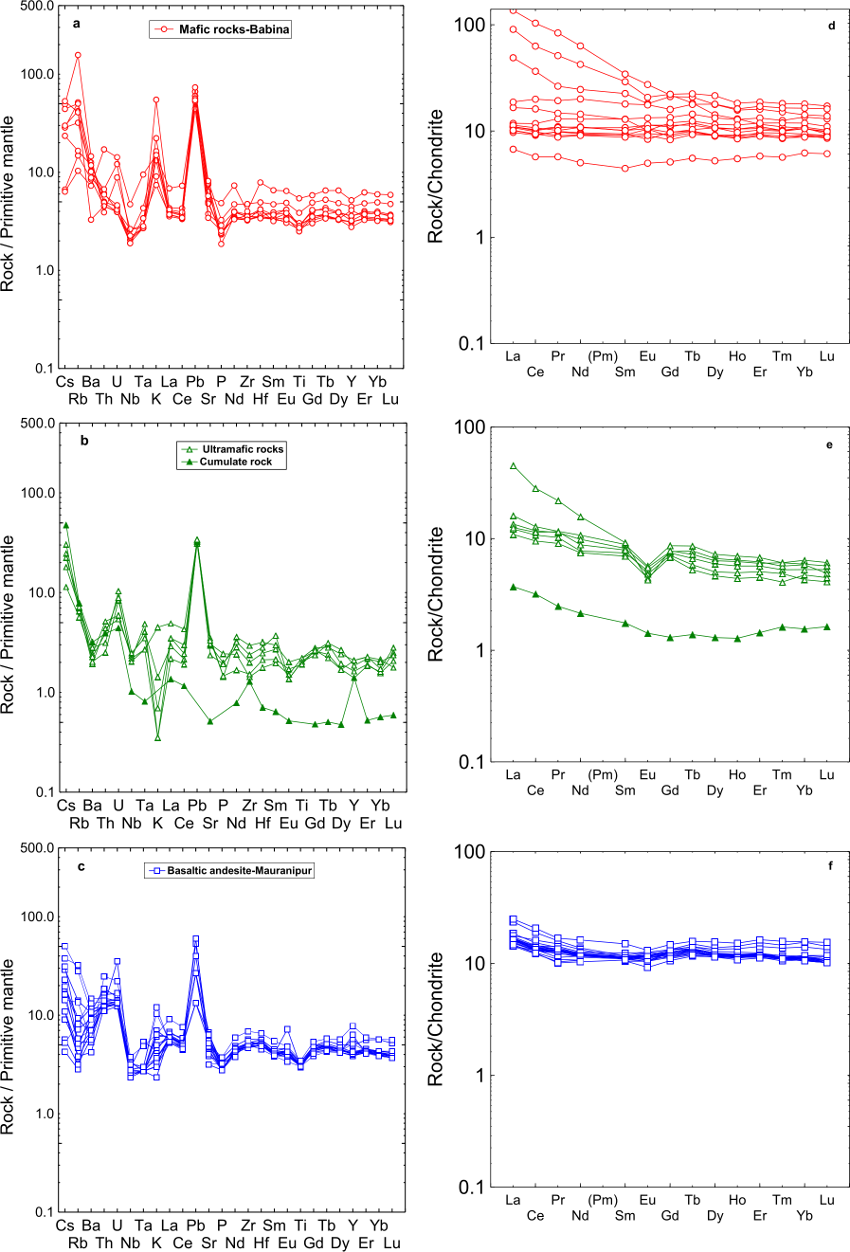
Fig. 5. (d–f) PM plots and chondrite-normalized plots (McDonough and Sun, 1995) for the ultramafic–mafic volcanic rocks.
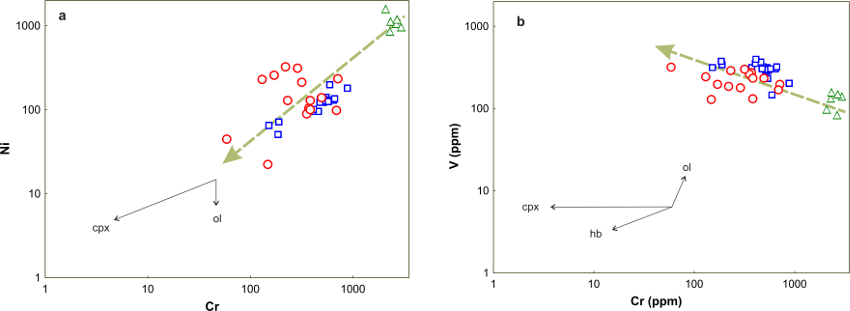
Fig. 6. (a) Cr vs. Ni, and (b) Cr vs. V bi-variate diagrams. The dashed arrow lines show clinopyroxene and olivine-dominated fractionation in the evolution of the ultramafic–mafic volcanic rocks from the Babina and Mauranipur greenstone belts.
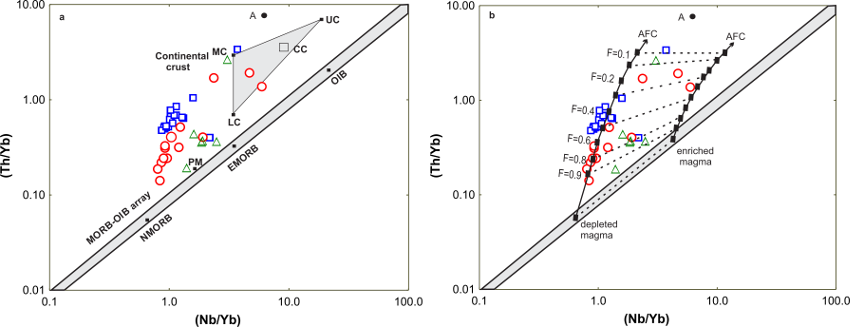
Fig. 7. (a) Petrogenetic modelling of the Nb/Yb–Th/Yb projection after Pearce (2008). a) Primordial Mantle (PM) and continental crust where (LC) average lower crust, (UC) upper crust, (CC) total continental crust, and (A) Archean crust for basaltic samples; nb) crustal contamination of depleted and enriched magmas with the continental crust; F denotes percentage of magma left.
Summary
- The ultramafic-mafic volcanic rocks emplaced at ~3.44 Ga in the Bundelkhand Craton.
- Trace element compositions show that the fractionation of clinopyroxene and minor olivine were the most likely process involved in the formation of the ultramafic–mafic volcanic rocks.
- Combined geochemical and εNdt (+0.2 to +9.0) results infer that mafic magma was produced from a depleted mantle source and evolved through fractional crystallization linked with crustal assimilation.
- The ultramafic–mafic volcanic rocks are remnants of oceanic crust. The foregoing results advocate that probable crustal assimilation during the evolution of these magmas and subduction prevailed during the Paleoarchean in the BC.
References
Arndt, N.T., Lesher, C.M., Barnes, S.J., 2008. Komatiites: New York. Cambridge University.
Chaudhuri, T., Satish-Kumar, M., Mazumder, R., Biswas, S., 2017. Geochemistry and Sm-Nd isotopic characteristics of the Paleoarchean Komatiites from Singhbhum Craton, Eastern India and their implications. Precambrian Research 298, 385–402.
Jayananda, M., Kano, T., Peucat, J.-J., Channabasappa, S., 2008. 3.35 Ga komatiite volcanism in the western Dharwar craton, southern India: constraints from Nd isotopes and whole-rock geochemistry. Precambrian Research 162, 160–179.
Joshi, K. B., Bhattacharjee, J., Rai, G., Halla, J., Ahmad, T., Kurhila, M., Heilimo, E., Choudhary, A. K., 2017. The diversification of granitoids and plate tectonic implications at the Archean–Proterozoic boundary in the Bundelkhand craton, Central India. In: Halla, J., Whitehouse, M.J., Ahmad, T., Bagai, Z. (eds) Crust–Mantle Interactions and Granitoid Diversification: Insights from Archean Cratons. Geological Society, London, Special Publications 449, 123–157.
Kaur, P., Zeh, A., Chaudhri, N., 2014. Characterisation and U–Pb–Hf record of the 3.55 Ga felsic crust from the Bundelkhand Craton, northern India. Precambrian Research 255, 236–244.
Kaur, P., Zeh, A., Chaudhri, N., Eliyas, N., 2016. Unravelling the record of Archean crustal evolution of the Bundelkhand Craton, northern India using U–Pb zircon–monazite ages, Lu–Hf isotope systematics, and whole-rock geochemistry of granitoids. Precambrian Research 281, 384–413.
Malviya, V.P., Arima, M., Pati, J.K., Kaneko, Y., 2006. Petrology and geochemistry of metamorphosed basaltic pillow lava and basaltic komatiite in the Mauranipur area: subduction related volcanism in the Archean Bundelkhand craton, Central India. Journal of Mineralogical and Petrological Sciences 101, 199–217.
Maya, M., Bhutani, R., Balakrishnan, S., Sandhya, S.R., 2017. Petrogenesis of 3.15 Ga old Banasandra komatiites from the Dharwar craton, India: Implications for early mantle heterogeneity. Geoscience Frontiers 8, 467–481.
McDonough, W.F., Sun, S.S., 1995. The composition of the Earth. Chemical Geology 120, 223–253.
Mondal, M.E.A., Goswami, J.N., Deomurari, M.P., Sharma, K.K., 2002. Ion microprobe 207Pb/206Pb ages of zircons from the Bundelkhand massif, northern India: implications for crustal evolution of the Bundelkhand–Aravalli protocontinent. Precambrian Research 117, 85–100.
Pearce, J.A., 2008. Geochemical fingerprinting of oceanic basalts with applications toophiolite classification and the search for Archean oceanic crust. Lithos 100, 14–48.
Saha, L., Frei, D., Gerdes, A., Pati, J.K., Sarkar, S., Patoke, V., Bhandari, A., Nasipur, P., 2016. Crustal geodynamics from the Archean Bundelkhand Craton, India: constraints from zircon U–Pb–Hf isotope studies. Geological Magazine 153, 179–192.
Silva, M.G. 1992. Evidências isotópicas e geocronológicasde umfenômeno de acrescimentocristal transamazônico no craton do São Francisco, Estadoda Bahia. In: XXXVVII Congresso Brasileiro de Geologia, São Paulo, SBG, Anais vol. 2, p. 181–182.
Singh, Pradip K., Sanjeet K. Verma, Juan A. Moreno, Vinod K. Singh, Vivek P. Malviya, Elson P. Oliveira, Sumit Mishra, Makoto Arima. 2019a. Geochemistry and Sm–Nd isotope systematics of mafic-ultramafic rocks from the Babina and Mauranipur greenstone belts, Bundelkhand Craton: Implications for tectonic setting and Paleoarchean mantle evolution. Lithos 330–331, 90–107.
Singh, P.K., Verma, S.K., Singh, V.K., Moreno, J.A., Oliveira, E.P., Mehta, P. 2019b. Geochemistry and petrogenesis of sanukitoids and high-K anatectic granites from the Bundelkhand Craton, India: Implications for late-Archean crustal evolution. Journal of Asian Earth Sciences 174, 263–282.
Singh, V.K., Slabunov, A., 2015. The central Bundelkhand Archean greenstone complex, Bundelkhand craton, central India: geology, composition, and geochronology of supracrustal rocks. International Geology Review 57, 1349–1364.
Singh, S. P., Subramanyam, K. S. V., Manikyamba, C., Santosh, M., Singh, M. R., Kumar, B. C. 2018. Geochemical systematics of the Mauranipur-Babina greenstone belt, Bundelkhand Craton, Central India: Insights on Neoarchean mantle plume-arc accretion and crustal evolution. Geoscience Frontiers 9, 769–788.
Verma, S.P. et al. (2017). Multidimensional classification of magma types for altered igneous rocks and application to their tectonomagmatic discrimination and igneous provenance of siliciclastic sediments, Lithos, v. 278-2811, p. 321-330

Comment from series editor, R. Ernst:
The Archean LIP record (e.g. Ernst 2014, Large Igneous Provinces, Cambridge U. Press) is incompletely preserved but it is being gradually sorted out through studies such reported in this December 2019 LIP of the Month, on a komatiite-bearing greenstone belt in Bundelkhand Craton, India.